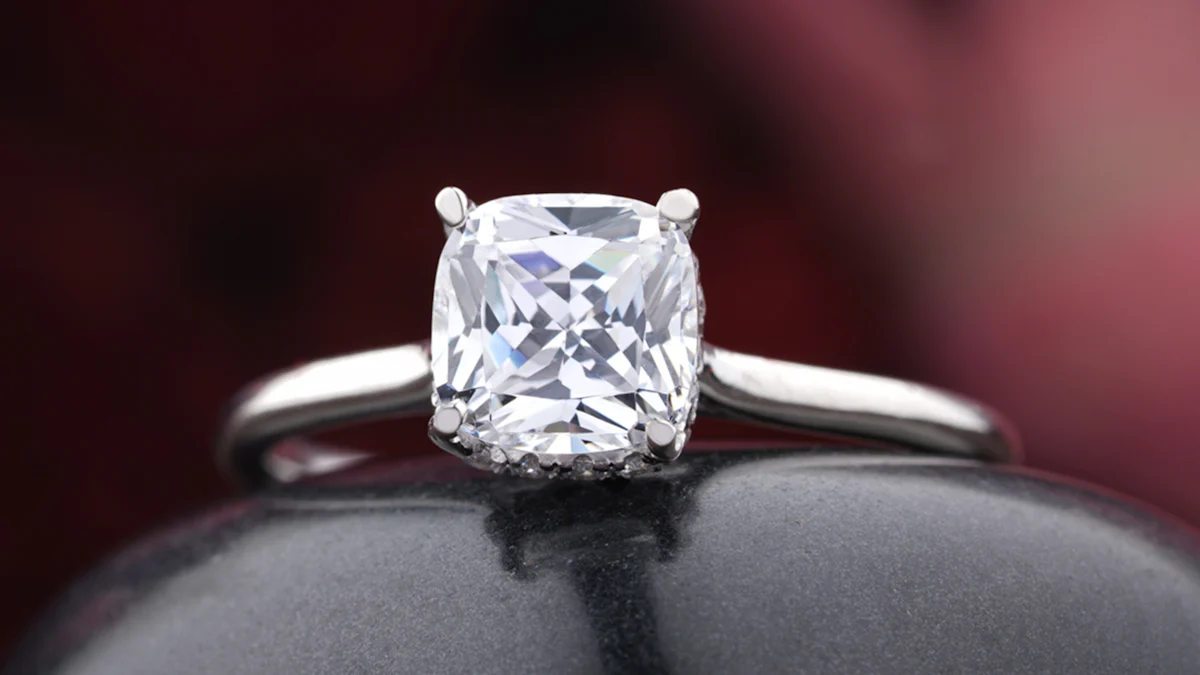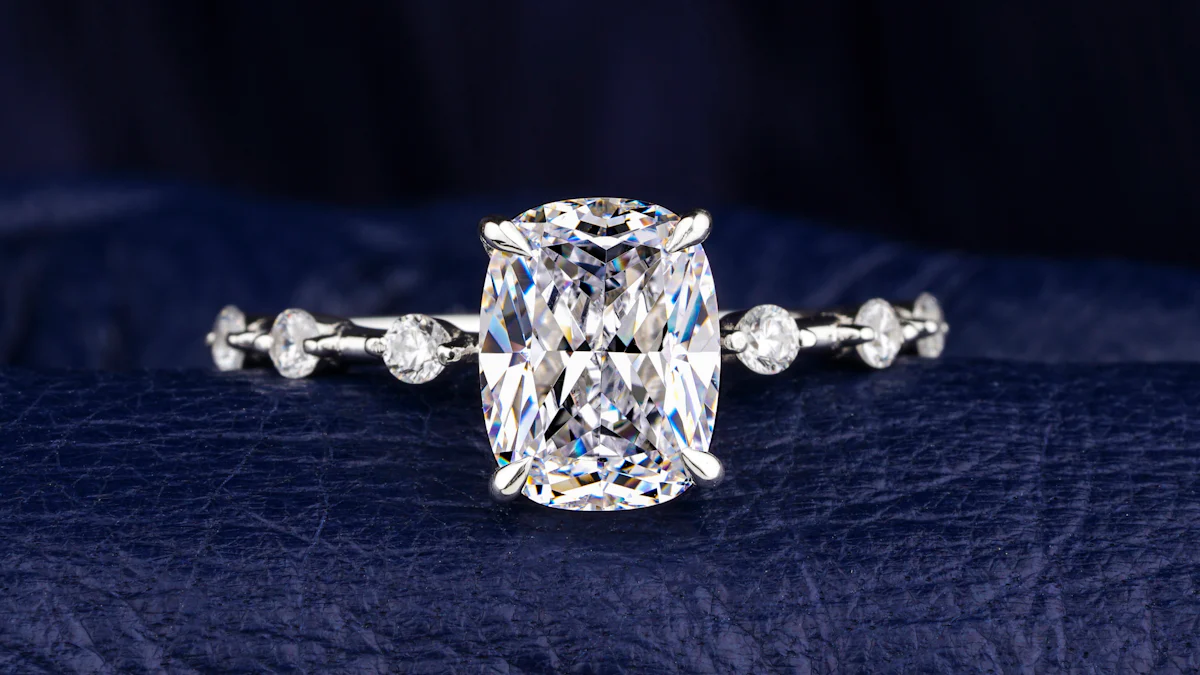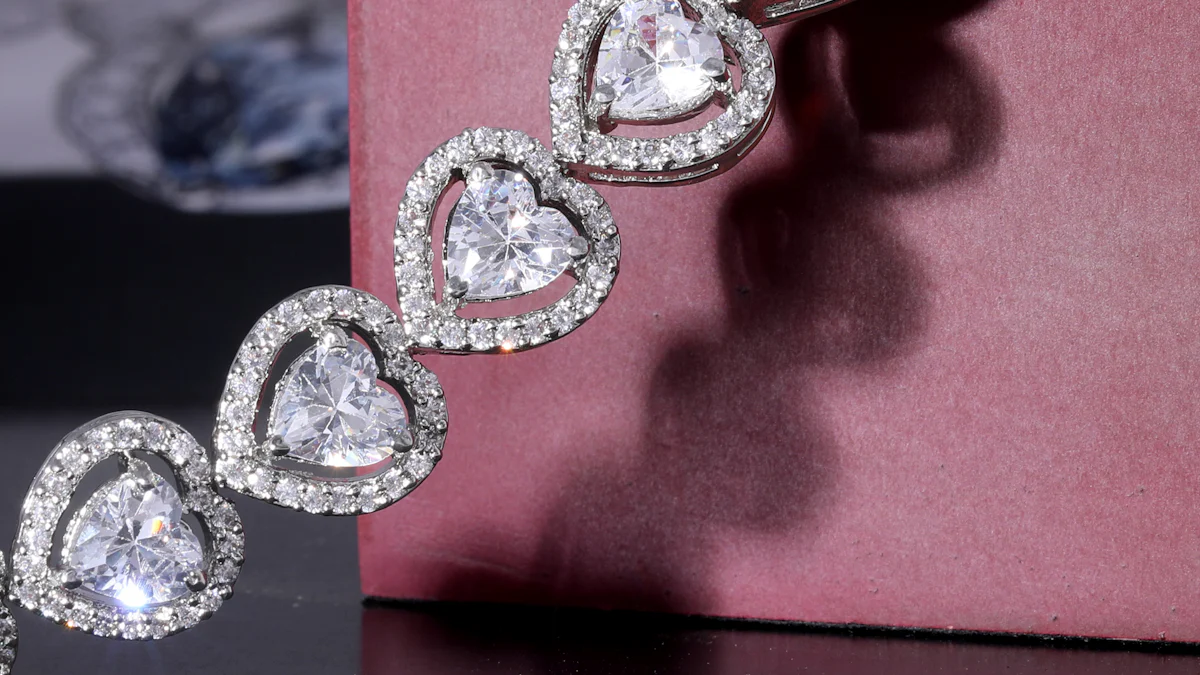How Carat Diamond Size Varies by Shape

When you think about diamonds, you might picture their sparkle and carat diamond size. But did you know that a diamond’s size isn’t just about its weight? Carat weight measures how much a diamond weighs, not how big it looks. The actual appearance of a diamond depends on its shape and cut. For example, a 1-carat round diamond typically measures around 6.5mm in diameter, while other shapes of the same weight might look larger or smaller. Understanding these differences helps you choose a diamond that feels perfect for you.
Key Takeaways
- Carat weight measures a diamond's weight, not its size; two diamonds of the same carat can look very different based on their shape and cut.
- Shapes like oval, marquise, and pear can make a diamond appear larger without increasing the carat weight, thanks to their elongated designs.
- Prioritize cut quality over carat weight; a well-cut diamond reflects light beautifully, enhancing its brilliance and perceived size.
- Use a diamond size chart to visualize how different shapes and carat weights correlate, helping you make an informed choice.
- Consider your personal style and lifestyle when selecting a diamond; the right shape can complement your hand and reflect your personality.
- Explore settings like halo designs to create the illusion of a larger diamond, maximizing visual impact without increasing carat weight.
Understanding Carat Weight and Its Impact on Diamond Size
What is Carat Weight?
Carat weight measures how much a diamond weighs. It’s one of the most important factors in determining a diamond’s value. One carat equals 200 milligrams, and jewelers often divide it into 100 points for precise measurements. For example, a 0.50-carat diamond is often called a “50-pointer.” While carat weight gives you an idea of a diamond’s size, it doesn’t tell the whole story.
However, don’t confuse weight with size. A diamond’s shape and cut can make two stones of the same carat weight look completely different.
Why Carat Weight Doesn’t Always Equal Size
You might think a higher carat weight means a bigger diamond, but that’s not always true. The way a diamond is cut and shaped plays a huge role in how large it appears. For instance, a round diamond and a marquise diamond of the same carat weight can look very different in size. The marquise shape often appears larger because of its elongated design.
The diamond’s depth also matters. A deeply cut diamond may hide much of its weight below the surface, making it look smaller when viewed from above. On the other hand, a shallow cut can spread the weight across a larger surface area, giving the illusion of a bigger stone. This is why understanding proportions is key when choosing a diamond.
Fun Fact: Two diamonds with identical carat weights can have different surface areas. A well-cut diamond maximizes its visible size, while a poorly cut one may appear smaller despite weighing the same.
How Carat Weight Affects Diamond Dimensions
Carat weight directly influences a diamond’s dimensions, including its diameter, height, and surface area.
The relationship between carat weight and dimensions isn’t linear. As carat weight increases, the diamond’s size grows, but not proportionally. A 2-carat diamond doesn’t look twice as big as a 1-carat diamond. Instead, it appears only slightly larger because the weight is distributed in three dimensions.
When selecting a diamond, focus on how the weight translates into visible size. A diamond with excellent cut proportions will reflect light beautifully and appear larger than one with poor proportions. This ensures you get the most brilliance and visual impact for your investment.
The Role of Shape in Carat Diamond Size

Overview of Popular Diamond Shapes
Each shape has unique characteristics that influence its appearance and how it reflects light. Some of the most popular diamond shapes include:
- Round Brilliant: Known for its unmatched sparkle, this classic shape maximizes brilliance and fire. It’s the most popular choice for engagement rings.
- Princess Cut: A square or rectangular shape with sharp corners, offering a modern and edgy look.
- Oval: An elongated shape that combines brilliance with a larger surface area, making it appear bigger than some other shapes.
- Marquise: A football-shaped diamond with pointed ends, designed to maximize carat weight and create the illusion of a larger stone.
- Emerald Cut: A rectangular shape with step-cut facets, offering a sleek and elegant appearance.
- Pear Shape: A teardrop design that blends the round and marquise shapes, creating a unique and flattering look.
Each shape offers something special. Your choice depends on your style and how you want the diamond to appear on your finger.
Which Shapes Appear Larger or Smaller for the Same Carat Weight?
Not all diamonds of the same carat weight look the same size. Some shapes naturally appear larger due to their proportions and surface area. If you want a diamond that looks bigger without increasing the carat weight, consider these shapes:
- Oval, Marquise, and Pear Shapes: These elongated shapes distribute weight across a larger surface area. For example, a 1-carat oval diamond often looks bigger than a 1-carat round diamond because of its length and width.
- Emerald Cut: With its large table surface, this shape can appear larger than other cuts of the same weight. Its clean lines and step-cut facets enhance its visual size.
- Round Brilliant: While it maximizes sparkle, it may appear slightly smaller compared to elongated shapes because its weight is evenly distributed.
- Princess Cut: This shape can look smaller than others of the same carat weight due to its depth and square proportions.
Pro Tip: If you want a diamond that looks larger, focus on shapes with more surface area on top, like oval or marquise cuts. These shapes create the illusion of a bigger stone without increasing the carat weight.
How Cut Quality Enhances Perceived Size
The cut quality of a diamond doesn’t just affect its sparkle—it also impacts how big it looks. A well-cut diamond reflects light beautifully, making it appear larger and more brilliant. Here’s how cut quality influences perceived size:
- Proportions Matter: A shallow cut spreads the diamond’s weight across a larger surface area, making it look bigger. However, if it’s too shallow, it may lose brilliance. On the other hand, a deep cut hides weight below the surface, making the diamond appear smaller.
- Symmetry and Polish: A diamond with excellent symmetry and polish reflects light evenly, enhancing its visual size and brilliance.
- Table Size: The table is the flat surface on top of the diamond. A larger table can make the diamond look bigger, but it needs to balance with the overall proportions to maintain sparkle.
When selecting a diamond, prioritize cut quality over carat weight. A smaller diamond with an excellent cut often looks more impressive than a larger one with poor proportions.
Fun Fact: Two diamonds with the same carat weight can look completely different in size and brilliance. Always check the cut grade to ensure you’re getting the most out of your diamond.
Diamond Size Chart: Correlating Carat Weight, Shape, and Dimensions

What is a Diamond Size Chart?
A diamond size chart serves as a handy guide to help you understand how carat weight translates into visible size. It provides a comparison between a diamond’s carat weight and its dimensions, usually measured in millimeters (mm). This chart is especially useful because diamonds of the same carat weight can look different depending on their shape and cut quality.
For example, a 1-carat round diamond typically measures about 6.5mm in diameter. However, a 1-carat oval diamond might appear larger due to its elongated shape. The chart helps you visualize these differences, making it easier to choose a diamond that matches your preferences. It also highlights how factors like depth and girdle thickness can influence the face-up size of a diamond. A shallow-cut diamond may appear larger, while a deep-cut one could look smaller despite having the same carat weight.
Quick Tip: Use a diamond size chart as a reference, but remember that actual dimensions can vary slightly based on the diamond’s cut and proportions.
Example Size Chart for Common Shapes and Carat Weights
To give you a clearer picture, here’s an example of how carat weight correlates with dimensions for popular diamond shapes. These measurements are approximate and can vary depending on the cut quality:
-
Round Brilliant:
- 0.50 carat: ~5.1mm diameter
- 1.00 carat: ~6.5mm diameter
- 2.00 carats: ~8.2mm diameter
-
Oval:
- 0.50 carat: ~6.0 x 4.0mm
- 1.00 carat: ~7.7 x 5.7mm
- 2.00 carats: ~10.2 x 7.0mm
-
Princess Cut:
- 0.50 carat: ~4.4 x 4.4mm
- 1.00 carat: ~5.5 x 5.5mm
- 2.00 carats: ~7.0 x 7.0mm
-
Marquise:
- 0.50 carat: ~8.5 x 4.0mm
- 1.00 carat: ~10.5 x 5.0mm
- 2.00 carats: ~13.0 x 6.5mm
-
Emerald Cut:
- 0.50 carat: ~5.0 x 3.5mm
- 1.00 carat: ~6.5 x 4.5mm
- 2.00 carats: ~8.5 x 6.0mm
These dimensions show how different shapes distribute weight differently. For instance, elongated shapes like oval and marquise tend to have larger surface areas, making them appear bigger than round or square shapes of the same carat weight.
Did You Know? Jewelers often use terms like “pointers” to describe smaller diamonds. A 0.01-carat diamond is called a “one-pointer,” while a 0.02-carat diamond is a “two-pointer.” These terms are common when discussing accent stones in jewelry.
When using a diamond size chart, focus on the shape and dimensions that align with your style. If you want a diamond that looks larger without increasing the carat weight, consider shapes like oval, marquise, or pear. These shapes maximize the visible size and offer excellent value for your investment.
Practical Tips for Choosing the Right Carat Diamond Size and Shape
Maximizing Size Within Your Budget
Finding the perfect diamond doesn’t mean you have to break the bank. You can make smart choices to get a diamond that looks larger without exceeding your budget.
Another way to maximize size is by focusing on cut quality. A well-cut diamond reflects light beautifully, creating brilliance that enhances its visual size. Even a smaller diamond with excellent cut proportions can outshine a larger one with poor cut quality. You might also consider slightly lower carat weights, such as 0.90 instead of 1.00 carat. The difference in size is minimal, but the price can be significantly lower.
Expert Tip: “While a larger carat size might seem impressive, it isn’t the sole indicator of a ring’s allure. I often suggest prioritizing a diamond’s cut and clarity over sheer size to ensure the ring’s brilliance and fire.” – Gemology Expert
Lastly, don’t overlook settings. A halo setting, for example, surrounds the center diamond with smaller stones, creating the illusion of a larger diamond. Choosing a thinner band can also make the center stone appear more prominent.
Matching the Diamond to Your Style and Preferences
Your diamond should reflect your personality and style. Think about how you want the diamond to look on your hand. Do you prefer something bold and eye-catching or delicate and understated? Shapes like round or princess cuts offer timeless elegance, while marquise or pear shapes make a unique statement.
Consider how the diamond complements your hand shape. For instance, elongated shapes like oval or emerald can make fingers appear longer and slimmer. Round diamonds, on the other hand, suit almost every hand shape and offer unmatched sparkle.
Expert Insight: “The size of a diamond can have a significant impact on its overall appearance and how it sparkles on your finger. A larger diamond can make a bold statement and catch the eye, while a smaller diamond can be delicate and elegant.” – Gemology Expert
Your lifestyle matters too. If you lead an active life, you might prefer a diamond shape and setting that’s durable and less prone to snagging, like a round or princess cut in a bezel setting. Ultimately, the right diamond is the one that feels like “you.”
Prioritizing Cut Quality Over Carat Weight
When choosing a diamond, cut quality should always come first. The cut determines how well the diamond reflects light, which directly impacts its brilliance and perceived size. A smaller diamond with an excellent cut will often look more dazzling than a larger diamond with a poor cut.
Focus on proportions. A diamond with ideal proportions will maximize its surface area and sparkle, making it appear larger. Avoid diamonds with deep cuts, as they hide weight below the surface and look smaller from above. Similarly, overly shallow cuts may lack brilliance, even if they appear larger.
Fun Fact: Two diamonds with the same carat weight can look completely different in size and brilliance. Always check the cut grade to ensure you’re getting the most out of your diamond.
Don’t let carat weight overshadow other factors like clarity and color. A well-cut diamond with slightly lower carat weight but excellent clarity and color will often look more stunning than a larger diamond with visible flaws. Remember, brilliance and beauty matter more than sheer size.
By keeping these tips in mind, you can confidently choose a diamond that fits your budget, matches your style, and sparkles brilliantly.
Carat weight defines a diamond’s weight, but its shape and cut determine how it looks and sparkles. You should focus on perceived size rather than just numbers.
FAQ
Why does diamond carat weight matter?
Carat weight plays a significant role in determining a diamond's price. It directly impacts the value of the stone, making it one of the key factors to consider when shopping for diamonds. A diamond's certification, such as one from the GIA (Gemological Institute of America), provides all the essential details about the carat weight and other characteristics. This ensures you know exactly what you're purchasing.
What does carat weight describe?
Carat weight measures the weight of a diamond or gemstone. It doesn’t describe the actual size but gives you an idea of how heavy the stone is. For example, a 1-carat diamond weighs 200 milligrams. While carat weight is often associated with size, the diamond's shape and cut influence how large it appears.
How are diamonds measured?
Diamonds are measured in carats, which refer to their weight rather than their physical dimensions. Jewelers use precise tools to calculate the carat weight, ensuring accuracy. For instance, a 0.50-carat diamond is half the weight of a 1-carat diamond, but its size can vary depending on its shape and cut.
Does a higher carat weight always mean a bigger diamond?
Not necessarily. While carat weight affects a diamond's size, the cut and shape determine how large it looks. A deeply cut diamond may appear smaller than a shallow-cut diamond of the same carat weight. Shapes like oval or marquise often look larger because they spread the weight across a bigger surface area.
What should you prioritize over carat weight when buying a diamond?
The overall appearance and brilliance of the diamond should take priority over carat weight. A well-cut diamond with excellent proportions reflects light beautifully, making it sparkle and appear larger. Choosing a diamond with an Excellent or Ideal cut ensures you get the most brilliance and visual appeal, even if the carat weight is slightly lower.
Why do diamonds of the same carat weight look different in size?
Diamonds of the same carat weight can look different due to their shape and cut. For example, a round diamond and a marquise diamond of the same weight will have different dimensions. The marquise shape often appears larger because of its elongated design, while the round shape distributes weight more evenly.
Is carat weight the only factor that affects a diamond's price?
No, carat weight is just one of several factors that influence a diamond's price. Other elements, such as cut, clarity, and color, also play a crucial role. A smaller diamond with excellent cut and clarity can cost more than a larger diamond with visible flaws or poor proportions.
How can you make a diamond look bigger without increasing the carat weight?
You can choose shapes like oval, marquise, or pear, which naturally appear larger due to their elongated designs. Additionally, selecting a diamond with a high-quality cut enhances its brilliance, making it look bigger. Settings like a halo or a thinner band can also create the illusion of a larger stone.
What is the difference between carat weight and size?
Carat weight measures the diamond's weight, while size refers to its physical dimensions, such as diameter or surface area. A 1-carat diamond may look different in size depending on its shape and cut. For instance, a 1-carat round diamond typically measures about 6.5mm in diameter, while a 1-carat oval diamond might appear larger due to its elongated shape.
Why is a diamond certification important?
A diamond certification, like one from the GIA, provides detailed information about the diamond's carat weight, cut, clarity, and color. It ensures transparency and helps you make an informed decision. Without certification, you might not know the true quality or value of the diamond you're purchasing.
See Also
A Guide to Engagement Ring Diamond Cuts
The Size Comparison of a 2.25 Carat Diamond
Discovering Various Styles of Wedding Diamond Rings

